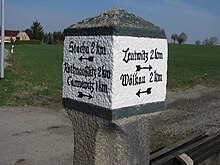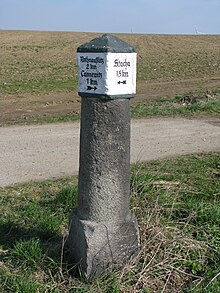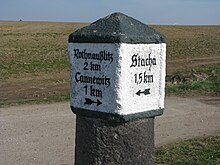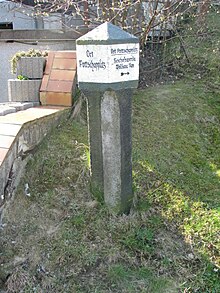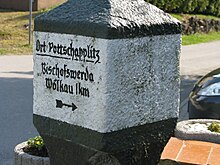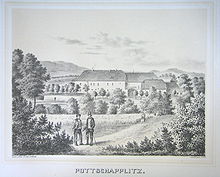Pottschapplitz
|
Pottschapplitz
Community Demitz-Thumitz
Coordinates: 51 ° 9 ′ 54 ″ N , 14 ° 15 ′ 7 ″ E
|
|
|---|---|
| Residents : | 62 (May 9, 2011) |
| Incorporation : | 1936 |
| Incorporated into: | Rothnaußlitz |
| Postal code : | 01877 |
| Area code : | 035930 |
Pottschapplitz ( Upper Sorbian Počaplicy , see Potschapl ) is a village in the south of the East Saxon district of Bautzen . It belongs to Upper Lusatia and has belonged to the Demitz-Thumitz community since 1994 . Before that it was a part of Rothnaußlitz .
The place is dominated by agriculture and there are still some farms and a former manor . The remaining buildings are purely residential buildings, most of which have been built or converted in the last 60 years. Today there are no more active farmers or active farms in the village, the fields are mostly cultivated by farmers or farms in the neighboring villages. The surrounding fields are cultivated only by the owner of the manor. The required agricultural machinery is also stationed in Pottschapplitz. In 2013, construction work began on a new machine hall.
The place currently has no stationary shops, only vending cars stop regularly. There are also no industrial or other production facilities in the area.
geography
Pottschapplitz consists of two parts approx. 300 m apart. The larger part with the manor is located in a depression through which the "Pottschapplitzer water" flows. The smaller part - also called "Neu-Pottschapplitz" - is located on a ridge on which the local road from Stacha to Cannewitz and Rothnaußlitz runs. In the 1930s, two larger artificial ponds were created in and outside the village, which are used on the one hand for fish farming and on the other to supply extinguishing water. These were absolutely necessary in the event of a fire, as a drinking water supply was only established via Wölkau in 1988.
history
The first probable documentary evidence comes from the Bautzner Dingbuch from 1364 as the manor house of Boemus de Cappelicz . However, 1374/82 the place can be proven with certainty in the interest register of the monastery St. Marienstern, since the named Puczaplicz had to give up rye and oats as tithe.
The originally Slavic place name has then changed in several intermediate steps to the German name “Pottschapplitz” and the Sorbian name “Počaplicy”. 1364 "de Cappelicz", 1374/82 "Puczaplicz", 1464 ff. "Poczschenplitz", 1488 "Potzschenplitz" "Potzschaplitz", 1490 "Potzenplitz", 1559 "Potzschapelitz", 1622 "Poczscheblicz", 1693 "Pezschepliz", 1712 " Potschaplitz ". The latest place name research assumes that the place name originated from a personal name: "Settlement of the people of Počapal or Počapala" (see also Potschappel ).
In 1488 Pottschapplitz was a Meissen fiefdom and in 1559 the manor, which still exists today, was first mentioned in a document. The residents of Großgehenchen (Meißner side), Zockau and Semmichau had already refused their lords from Pottschapplitz the increased "full court services" in the summer of 1614 when they were outraged about the increased burdens in 1615.
Although the small town appears to be quite insignificant, it and its immediate surroundings were the scene of battles or marches through the wars in 1760 and 1813.
In the Seven Years' War there was an order with the following text: “The march of the infantry of the right wing goes from Salzförstchen .... towards Nedaschütz and from here queer over the hill, towards Potzschaplitz; where these troops sit in the flank of the enemy, form batteries, and wherever they need to cannon. "
During the Wars of Liberation, the Prussian major Graf Lehndorff led the 3rd, 4th and Jäger Escadrons of the East Prussian National Cavalerie Regiment in an attack against French troops on September 23, 1813. They had occupied the tavern on the Chaussee near Rothnaußlitz . For September 24, 1813, there was a report that General Baron von Sacken, coming from Pietzschwitz , could not carry out the bypass "to Pottschapplitz" before nightfall. The attack on the troops standing at Kleinförstchen therefore had to be postponed until the following day. Nevertheless, an attack on Pottschapplitz appears to have taken place on the night of September 24th to 25th. But this probably only showed that the French troops had already withdrawn.
Apparently there had also been billeting of soldiers in the Pottschapplitz manor. In his diary, Rudolf von Bünau (1808–1880) remembers how as a little boy he was taken on horseback by the Cossacks housed in Russia.
Even the Second World War did not leave the place unscathed. There was probably no fighting in Pottschapplitz, but the older residents can still remember an incident with a Soviet tank. This drove away from the streets and paths from north to south across the town towards Wölkau. Although only a few fences were destroyed, the fear / uncertainty of the residents was great.
The former windmill that stood above the former youth club no longer exists today. Only large boulders in the field are reminiscent of the building. In the course of the increasing population in the past centuries, large parts of the forest around the village were cleared. Today, between Pottschapplitz and Stacha, there is only a single oak in a wide field, which used to represent the border of a large forest between the two villages. At that time, this forest extended to the large pond. The former large estate on this oak no longer exists today.
Until the beginning of the 20th century, Pottschapplitz was mostly inhabited by Sorbs . The scientist Arnošt Muka had 114 inhabitants in 1884/85, 100 of whom were Sorbs. In the course of the century, the use of the Sorbian language fell sharply.
Until 1936 Pottschapplitz formed an independent rural community with the district Wölkau (Meißner part). Then it was incorporated into Rothnaußlitz.
In 1959, as part of the land reform and expropriation, the local farmers merged to form the LPG Pottschapplitz, which was closed after the fall of the Wall.
The number of inhabitants is at a historic low today, which can be explained by the partial migration of young people to economically better off regions and of course the falling birth rate. Like almost the entire Upper Lusatian region, the place is suffering from creeping aging.
Path pillars
There are several historical pillars in and around the place. These were restored a few years ago and are now easy to read again.
| Location | overall view | Close up view | Close up view |
|---|---|---|---|
| 51 ° 10 ′ 05.6 ″ N , 014 ° 15 ′ 03.6 ″ E | |||
| 51 ° 10 '14.1 " N , 014 ° 14' 38.1" E | |||
| 51 ° 09 ′ 52.3 " N , 014 ° 14 ′ 59.3" E |
Manor / manor
In the year 1559 in the chronicle of Bischofswerda a "Hans v. Maren had Pottschappliz as a fief" is mentioned. Today's manor house of the manor goes back to Adam Gottlieb Zwirner. The town clerk of Bischofswerda bought the estate in 1709 and had a two-story baroque building with two portals built. The basket arch of the right portal shows the year 1717, the monogram AGZ (Adam Gottlieb Zwirner) and the coat of arms. The coat of arms is divided into black and gold by a silver rafter, underneath the black thread ball.
When Zwirner died in 1740, he was mayor of Bischofswerda. His widow sold the manor in 1761 to a Herr von Criegern, who in 400 years was followed by around 50 other mostly bourgeois owners and tenants. In 1791 Jacob Heinrich (Württemb. Major) married a Sophia Eleonora Reut, b. Thielemann on Pottschapplitz near Bischofswerda.
In a land register of a piece of land in the village, two owners have been named as manor owners. In the said land register there is a Mr. Robert Julius Döring entered, but whether this was also the owner of the manor cannot currently be proven with certainty. The subsequent change of ownership of the manor in 1890 to Mr. Dr. jur. Hans Otto and again in 1905 Richard Max Schulze are considered safe. This is also confirmed by the tax documents of the municipality of Pottschapplitz from 1880 to 1930. Unlike the larger estates, the Pottschapplitz manor did not fall under the land reform after the Second World War. Like the other farms in the village, the manor was brought into the LPG more or less voluntarily. Since then, several apartments have been housed in the manor house. The LPG used the buildings of the courtyard, which had been converted on four sides, as stables, storage rooms, offices and apartments. The large barn directly opposite the manor house was demolished after 1990 because it was very dilapidated. The buildings that have been preserved are also waiting for a thorough renovation. The Schulze family regained their property after reunification, but sold the entire manor a few years later. The current owner comes from and lives in the old federal states.
Unfortunately, the adjoining small park has also lost its neat appearance and only reminds of its former glory through the magnificent trees.
Overview of the owners / tenants of the Pottschapplitz manor
| year | owner | Remarks | proof | source |
|---|---|---|---|---|
| 1477 | Carlowitz | pretty sure | ||
| before 1488 | Oswald von der Olßnitz | a third of 3 1/2 marks interest | pretty sure | |
| from 1488 | Christoph von Haugwitz | one third | pretty sure | |
| from 1488 | Hans von Mynnewitz zu Naußewitz | one third | pretty sure | |
| 1490 | Alex von Naußelitz | one third | pretty sure | |
| from 1499 | Melchior and Hans von Haugwitz | one third | pretty sure | |
| 1519 | Nikel, Hans, Melchior, Balthasar von Tschirnhausen brothers | a third ("like her father Alex had") | pretty sure | |
| before 1559 | Hans v. Hermsdorf | one third ? | unsure | |
| 1559 | Hans v. Maxen | one third ? | pretty sure | |
| 1559 | Partial sale to Georg von Maxen | one third ? | unsure | |
| 1592-1609 | Caspar von Klüx | unsure | ||
| 1607 | Paul Rohrscheidt | unsure | ||
| 1609 / 10-1672 | Ernst Albrecht von Alnpeck | unsure | ||
| 1672-1709 | Christoph III Vitzthum von Eckstädt | unsure |
|
|
| 1709-1740 | Adam Gottlieb Zwirner | for sure | various sources | |
| 1740-1761 | Widow / descendant of Zwirner | for sure | various sources | |
| after 1761 | Karl Friedrich von Warriors | unsure |
|
|
| after 1761 | v. Oppel | unsure | ||
| after 1761 | v. Wangenheim | unsure | ||
| after 1761 | v. Linnenfeld | unsure | ||
| before 1823 | Rudolf von Bünau | pretty sure | ||
| xxxx-1828 | Imperial Knight Edler von Ehrenthal | for sure | Local chronicles | |
| 1828-xxxx | Friedrich Eduard Uhlmann | for sure | Local chronicles | |
| xxxx-1890 | Robert Julius Döring | unsure | Land register no.18 | |
| 1890-1905 | Dr. jur. Hans Otto | for sure | Land register Hs. No. 18, tax documents | |
| from 1905 | Max Schulze | for sure | Land register Hs. No. 18, tax documents | |
| from 19XX | Mr. Alkhofer | for sure | Municipal administration / residents |
literature
- Hans Neumann, Werner Schmidt (ed.): Lausitzer Bergland around Pulsnitz and Bischofswerda (= values of our homeland . Volume 40). 1st edition. Akademie Verlag, Berlin 1983.
- Matthias Donath , Lars-Arne Dannenberg (eds.): Castles in western and central Upper Lusatia , edition Sächsische Zeitung, 2008
- Tax documents of the municipality of Pottschapplitz approx. 1880–1930
- Extract from the land register, house no.18
- Chronicle of the royal Saxons. City of Bischofswerda by Karl Wilhelm Mittag from 1861
- Entre Chien et loup volume 1 page 276
Web links
- Pottschapplitz in the Digital Historical Directory of Saxony
Individual evidence
- ↑ Small-scale municipality sheet for Demitz-Thumitz. (PDF; 0.23 MB) State Statistical Office of the Free State of Saxony , September 2014, accessed on February 2, 2015 .
- ↑ Military Monthly, Volume 1
- ↑ The Royal Prussian Guard Hussar Regiment and its descent, 1811–1869
- ↑ The life of Field Marshal Count Neithardt von Gneisenau
- ↑ Carl Friedrich Wilhelm von Reyher, General of the Cavalry and Chief of ...
- ↑ von-buenau.de: Bünau - History
- ↑ Ernst Tschernik: The development of the Sorbian population . Akademie-Verlag, Berlin 1954.
- ^ Adelslexikon der Prussischen Monarchy, Volume 1
- ↑ a b c d e f g h Archive for Saxon History, Volume 6
- ↑ a b c d e f g Saxony - castles and mansions: Pottschapplitz
- ↑ a b c Schlossarchiv.de: Pottschapplitz
- ^ Genealogy of Hoch-Adelich Parents and Children, Volume 1
- ↑ Genealogical Handbook of Noble Houses "
- ↑ von-buenau.de: Bünau - History
- ↑ a b Uhlme family chronicle on uhlme.de


